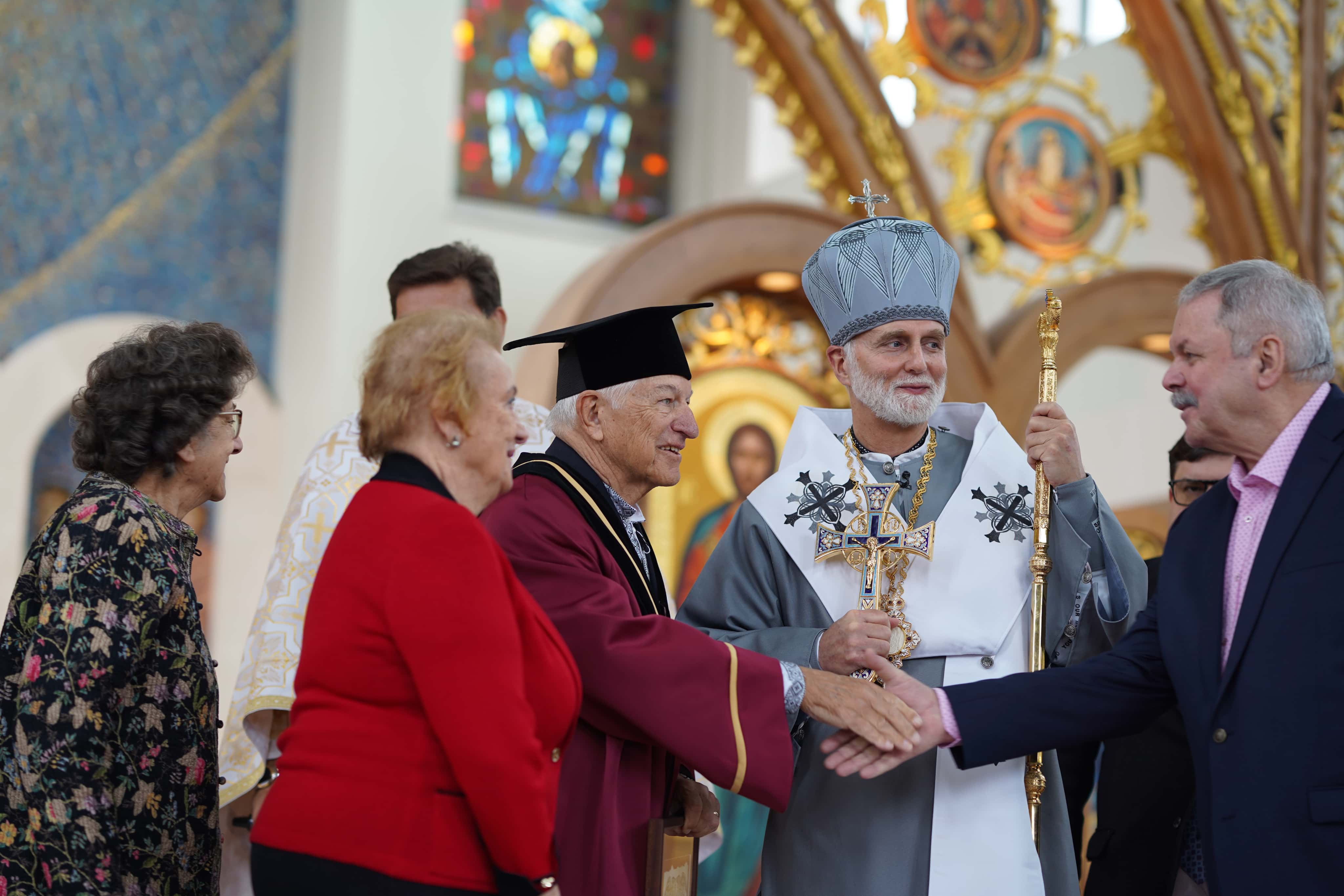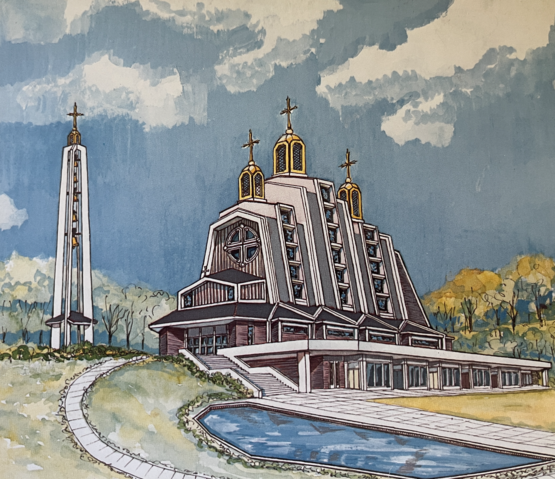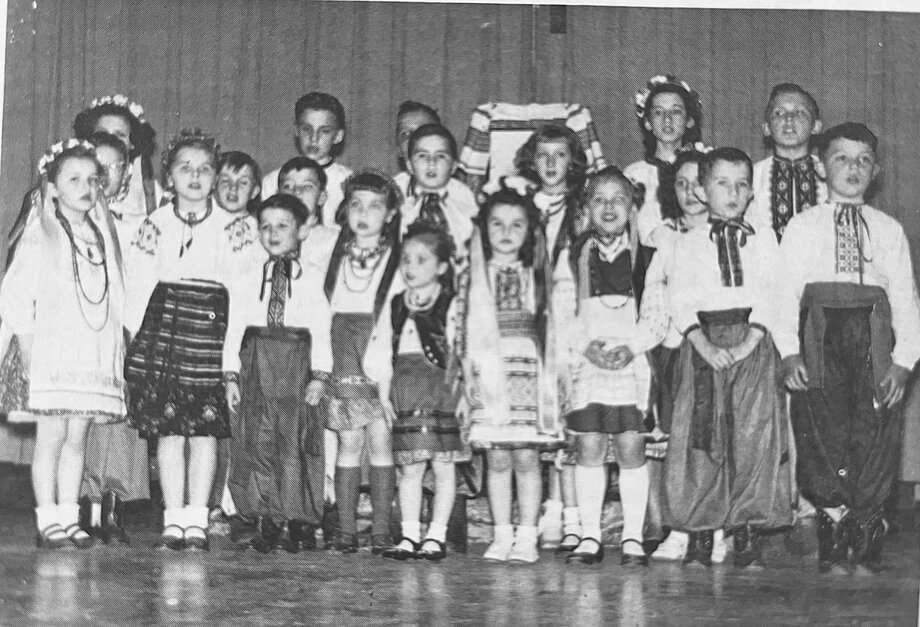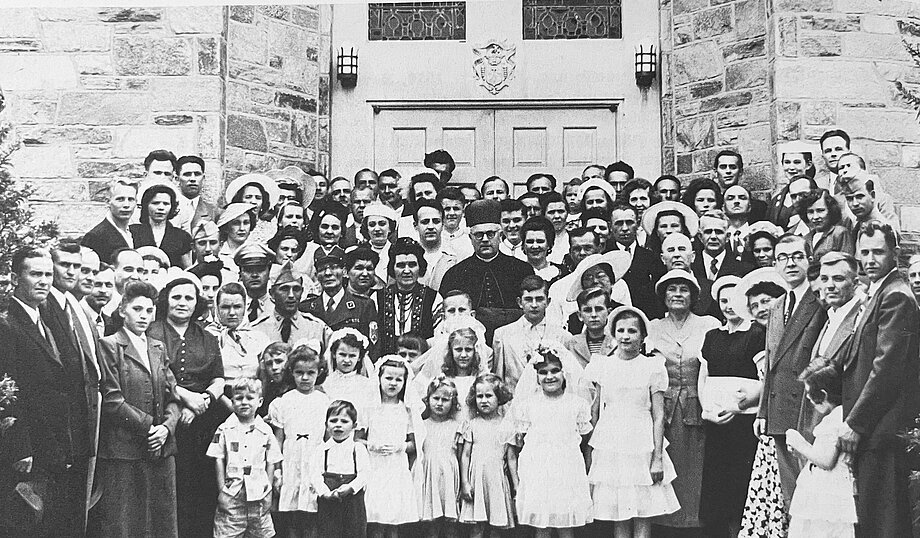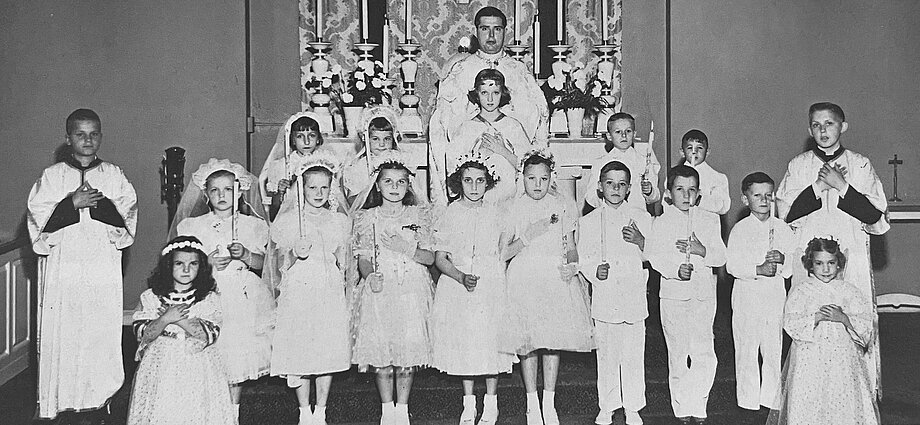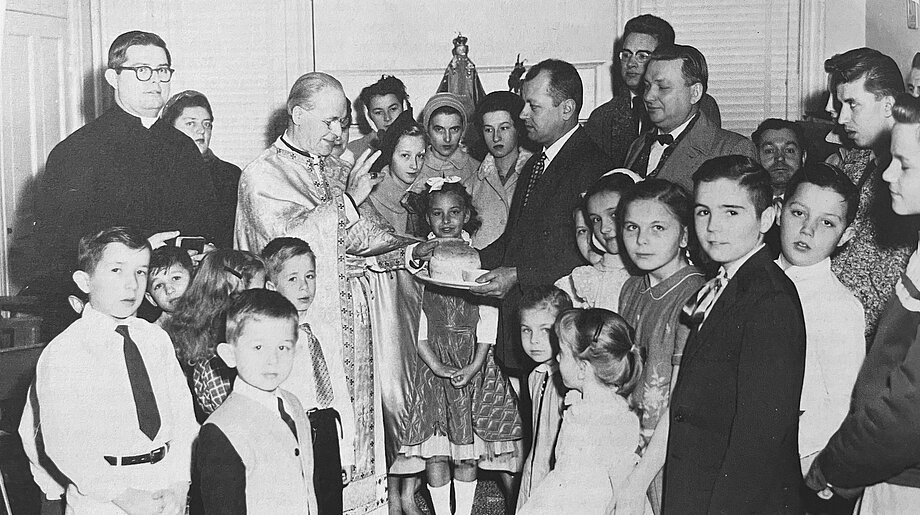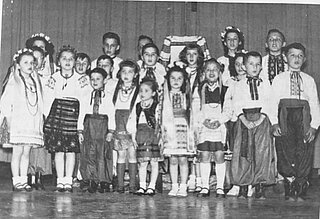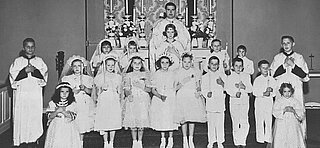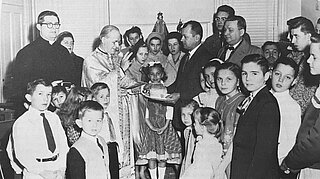- Christmas Appeal 2025
- Archeparchy
- Our faith
- Offices and ministries
- News
- Events
- Parishes
- Youth Protection
Holy Family parish in DC celebrates 75th anniversary: a brief history of the parish
Holy Family parish began when Archbishop Constantine Bohachevsky appointed Fr. Vladimir Wozniak to minister to Ukrainian Catholics in Washington, D.C. Fr. Wozniak celebrated the first Divine Liturgy for parishioners on Sunday, June 19, 1949 in the Roman Catholic Chapel of the Discalced Carmelite Monastery on Lincoln Road, N.E. He also suggested the name Holy Family, established the first church committee, and organized a parish choir. The first parish residence was at the St. Josaphat Seminary, then at 1938 Summit Place, N.E.
The second pastor, Canon Volodymyr Pylypec, took charge on November 1, 1950. He rented a building at 3419 12th Street, N.E., for a rectory. From May 1952 until 1962, Divine Liturgies were celebrated at the St. Vincent de Paul Chapel, 3802 Brookland Avenue, N.E.. On November 17, 1950, Holy Family parish accepted the Gregorian calendar. Following Fr. Pylypec, Fr. Henry Sagan, Fr. John Litwak, and Fr. Paul Harchison served for brief periods between April 1955 and March 1956. Fr. Sagan began publishing parish Sunday bulletins.
In March 1956, Fr. Theodore Danusiar arrived, to serve as pastor for the next 11 years. He purchased a parish residence at 3900 4th Street, N.W., where he recited Divine Liturgies each Sunday, with an English sermon, while the sung Liturgy, with Ukrainian sermon, continued to be celebrated at the St. Vincent de Paul Chapel.
In September 1960, Fr. Danusiar organized a planning committee, to examine 13 possible sites for a church in Washington, but parishioners could not agree on any of them. In 1961, the parish sold the 4th Street residence and acquired a property at 4817 Blagden Avenue, N.W., which was remodeled to accommodate a chapel, a rectory, and classrooms. Later, the committee made plans to build a church alongside the residence, and began a fund raising campaign. Fr. Danusiar established many new parish organizations and programs, like altar boys, regular religious education classes, and the pyrohy ladies.
In August 1967, the Ukrainian Redemptorist Fathers took charge of the parish, appointing Fr. Volodymyr Krayewsky, CSSR, pastor and Fr. Myron Sozansky, CSSR, assistant. Fr. Krayewsky established the Mariyska Druzyna of St. Josaphat (Marian Sodality), and at his request Major Archbishop Cardinal Josef Slipyj celebrated a Solemn Divine Liturgy on August 2, 1968, at the Holy Family Chapel. Fr. Krayewsky formed a new building committee, which concluded that plans to build a church at the Blagden Avenue site were not feasible.
Fr. Sozansky became pastor in 1969. Under his guidance, an expanded building committee examined a number of sites (including the Harewood Road property that ultimately was purchased in 1976), and concluded that they were too expensive. In 1970, he reorganized the committee, which examined additional sites in Virginia and Maryland, none of which seemed suitable.
Fr. Stephen Shawel, CSSR, assumed the pastorate in 1972. Fr. Andrew Krafcik, CSSR served as associate pastor from 1972 to 1973, and Fr. Joseph Korba, CSSR, was associate pastor from 1973 to 1974. In January 1973, Fr. Shawel recommended that the new church be built in the District of Columbia, in the Catholic University area, near St. Josaphat’s Seminary, because there it would be centrally located and accessible to all parishioners in the metropolitan area. A poll of parishioners indicated that the majority supported his view.
In 1973, Fr. Joseph Denischuk, CSSR, joined Fr. Shawel as associate pastor. Fr. Denischuk’s belief that Holy Family’s church should be a national shrine for all Ukrainian Catholics in the United States eventually became a reality. On February 28, 1974, Fr. Michael Hrynchyshyn, CSSR, Provincial of the Ukrainian Redemptorists, together with Fr. Shawel and Fr. Denischuk, inspected the six sites previously under consideration. They chose the site adjacent to St. Josaphat’s Seminary, at Harewood Road, N.E., owned by the Society of the Atonement, for the new church. The property was purchased in March 1976.
Meanwhile, parishioners elected a parish council and a new Building Committee, many of whose members remained for almost the life of the project. Michael Waris, Jr. served as chairman for the next 24 years. The building committee, the trustees and the pastors chose a design for the church by architect and parishioner Miroslav Nimciv in August 1975. The decision was made at the outset to erect a Ukrainian Catholic National Shrine, a symbol in the nation’s capital of the Ukrainian Catholic faith. This intent ultimately received the expressed concurrence of the bishops and their successors from all four Ukrainian Catholic Eparchies in the United States.
Most Reverend Basil Losten, Auxiliary Bishop of Philadelphia blessed the site in September 1975. At the same ceremonies, Fr. Denischuk, Campaign Director, and Mr. Waris, Campaign Chairman, launched the Memorial Fund Raising Campaign for the building of the Shrine. Over the course of the next 13 years, Fr. Denischuk traveled over 200,000 miles, visited nearly 200 parishes in the U.S. and Canada, and raised several times the original goal of $500,000.
In 1973, Fr. Shawel received permission from Metropolitan Senyshyn to celebrate one Sunday Divine Liturgy mostly in English. The parish officially marked its 25th anniversary at a Christmas Prosphora in January 1975.
In 1977, Bishop Losten blessed the Shrine foundation stone, and in September 1978, a representative of Metropolitan Archbishop Joseph Schmondiuk officiated at the groundbreaking ceremony. The first phase of construction, the Shrine Center, which includes a large auditorium, where Sunday Liturgies were held, a smaller meeting hall, classrooms and offices, a library, a Ukrainian religious gift shop, a kitchen, a stage and other facilities for religious, cultural and social purposes, was completed in 1979-1980. The Shrine cornerstone was blessed by the Holy Father Pope John Paul II during his visit to Washington on Saturday of Columbus Day Weekend, October 7, 1979. Cardinal Myroslav Lubachivsky, Cardinal James Hickey, Metropolitan Maxim Hermaniuk, and Bishop Losten presided at the laying of the cornerstone and the dedication of the Shrine Center on September 14, 1980. Since its opening, the Shrine Center has served as a community center, the scene of many impressive events, including religious conclaves, interfaith services and meetings, and visits by diplomats and, in 1987, President Ronald Reagan.
During this period, Fr. Denischuk introduced the devotion to the Pilgrim Icon of the Mother of God of Pochayiv to Holy Family parish. Spearheaded by Michael Kosciw, Fr. Denischuk, and Paul Yarrish, the first Ukrainian Catholic council of the Knights of Columbus, St. Josaphat Council 7530, was chartered on March 25, 1980, and quickly became a vital part of the parish. The Holy Family Parish Bingo, organized by Fr. Denischuk and several volunteers from the council, began in January 1981.
After celebrating his fiftieth anniversary as a priest at Holy Family in 1984, Fr. Shawel died on June 15, 1986, at the age of 75, and was buried at the Ukrainian section of Cedar Hill Cemetery in Suitland, MD. Fr. Denischuk served as Administrator until the arrival of a new pastor, Fr. Michael Kuchmiak, CSSR, in August 1987. In March 1988, Fr. Kuchmiak was named Auxiliary Bishop of Philadelphia, in addition to his duties at Holy Family. In August 1987, two parishioners who had entered the deaconate program, Donald Latrick and Theophil Staruch, newly designated as Eucharistic Ministers, distributed Holy Communion at the Divine Liturgies for the first time.
After three years of planning and preparations, construction of the upper structure of the Shrine began in December 1986, and was completed in the summer of 1988. Metropolitans Sulyk and Hermaniuk and Bishop Kuchmiak presided over the blessing of the exterior upper structure in September 1988. Unfortunately, major roof leaks appeared almost immediately, a problem that took several years to resolve.
In October 1989, Bishop Kuchmiak was installed as Apostolic Exarch for Ukrainian Catholics in England. Holy Family’s new pastor, Fr. Thaddeus Krawchuk, CSSR, arrived in Washington in December. After 16 and 1/2 years at Holy Family, Fr. Denischuk returned to Canada in the summer of 1990. Fr. Krawchuk faced several huge challenges. After a year and one-half of futile attempts to repair the roof, tower domes, windows and south and north walls, the parish entered into litigation. After 36 months an equitable settlement was reached, and Fr. Krawchuk and the building committee hired a new contractor to reconstruct the Shrine roof in accordance with re-engineered specifications. The reconstruction was completed by James R. Walls Co. of Clinton, Maryland, who received a roofing industry award for their work on the project.
To deal with the financial challenges and complete the interior construction and decoration of the Shrine, Fr. Krawchuk, with the tentative agreement of all the Ukrainian Catholic bishops in the United States, launched Campaign 2000, a fundraising effort designed to elicit support from Ukrainian Catholics throughout the U.S., in January 1995. Fr. Krawchuk and the trustees also initiated publication of a nationwide Shrine newsletter in April 1996. Walter Keyes edited the first newsletter. He was followed by Dr. John Fedkiw who edited the newsletter until 2008 and helped develop it into an important communication vehicle for the Shrine as well as a steady fund raiser.
In February 1995, Fr. Krawchuk announced that outstanding balances on all loans had been prepaid, with the help of generous bequests by the late Gerald A. Smith of Niagara Falls, New York. The Shrine also benefited greatly from a bequest by the late Lucille A. Tymm of Hyattsville, Maryland. Soon, as a result of fundraising efforts, Holy Family had accumulated substantial building funds.
Fr. Krawchuk encouraged the organization of a Rosary Altar Society at Holy Family and erected it as a chapter of the Confraternity of the Holy Rosary in October 1991. Fr. Deacon Latrick and Fr. Deacon Staruch were ordained at the Ukrainian Catholic Cathedral in Philadelphia in November 1990, and began to regularly assist in celebration of the Divine Liturgies.
In June 1996, the Redemptorist Fathers announced that they would relinquish the responsibility of staffing parishes, including Holy Family. Fr. Krawchuk and Brother John Kanski departed in June 1996, leaving the Shrine with a leak-free roof, its debts paid, savings of $540,000 in the bank, and Campaign 2000 in its second year. The future completion of the Shrine seemed assured.
Monsignor John Bura of St. Josaphat’s Seminary and Fr. Henadiy Mykhayluyk served the parish until the arrival of Fr. Petro Semenych as Administrator of Spiritualities on November 1, 1996. Fr. Deacon Staruch was named Administrator of Temporalities. Fr. Semenych was reassigned in September 1997, and on October 4, 1997, Fr. Wasyl Kharuk became Administrator of Spiritualities. On December 1, Fr. Kharuk was named Parochial Vicar (Assistant Pastor in residence for the Shrine parish) and pastor for the parishes of St. Mary’s in Manassas, Virginia, and St. John the Baptist, in Richmond, Virginia. Fr. Taras Lonchyna became pastor of Holy Family while retaining his pastor responsibilities for Holy Trinity Particular Ukrainian Catholic Church in Silver Spring, MD.
Planning continued for completion of the Shrine, but momentum had dissipated. Building funds continued to accumulate, but projected costs also grew, at a faster pace. Campaign 2000 had not lived up to expectations. The rapid turn-over of pastors weakened parish leadership. With a taxing work schedule, the priests faced multiple and potentially conflicting responsibilities and demands. Parishioners, concerned that the interior of the Shrine church might never be finished, appealed to Metropolitan Sulyk and the Redemptorist Fathers, who agreed to provide more stable pastoral leadership and a strong commitment to completion of the Shrine.
Fr. Thaddeus Krawchuk returned to Holy Family in May 1998 with the express hope of completing the Shrine. He reinvigorated the Building Construction Committee, with Walter Keyes as Chairman. Fr. Krawchuk asked the Metropolitan to revive Campaign 2000 and extend it to cover its less than effective early years. He laid the groundwork for a Parish Advisory Council and a number of other committees and teams to assume various responsibilities at the Shrine. Fr. Krawchuk, Mr. Keyes, and Thomas Yarrish spent the spring and summer finding ways to reduce construction costs and gain legal occupancy by the end of 1999, within the limits of available building funds. They modified the original plans to lower construction costs, while allowing for upgrades when more funds became available. Their plans and a contract proposal were approved by Archbishop Sulyk after review and modification. In January 1999, the parish contracted with the Saylor Construction Company to complete the interior of the Shrine Church. AEO Construction Company, supervised by David DiQuollo of Seal Engineering, completed the flat terrace roof.
Construction on the interior progressed ahead of schedule. The Shrine received an iconostas from Bishop Losten and the parishioners of St. Nicholas Ukrainian Catholic Church of Buffalo, New York, to be used until a permanent one could be built. A committee chaired by Fr. Deacon Staruch planned a gala banquet with distinguished guest speakers, a commemorative jubilee publication, exhibits, and production of special souvenir items to celebrate completion of the Shrine and the parish’s fiftieth anniversary. Metropolitan Sulyk and Bishop Kuchmiak presided over the dedication of the completed Shrine, concelebrated a Hierarchical Divine Liturgy, and partook of the banquet, together with over 400 parishioners and guests from as far away as California, Texas, Florida and New York, on 9-10 October 1999.
His task complete, Fr. Krawchuk was reassigned, and his place as pastor taken by Fr. Nestor Iwasiw in November 2001. Under Fr. Iwasiw’s leadership, the remaining mortgage on the church was paid off and a parish residence purchased in the “Little Ukraine” area of Hyattsville, MD. The Shrine bell tower, which had become rusted and unsightly, was repaired and painted and the bells restored to working condition with the help of funds raised by the Knights of Columbus. The Shrine witnessed a number of important events, including a gathering of the Synod of the Ukrainian Greek Catholic Bishops led by the Patriarch, His Beatitude Lubomyr Cardinal Husar, in October 2007. Under the guidance of Metropolitan Archbishop Stefan Soroka, a much closer and mutually beneficial and supportive relationship developed with St. Josaphat’s Seminary, which culminated with the appointment of the Rector, Fr. Robert Hitchens, and Spiritual Director, Fr. Wasyl Kharuk, as parish priests in January 2009, when Fr. Iwasiw was transferred to Olyphant, PA. Under their pastoral care, the shrine and parish began an effort to become stronger and holier by commemorating the past through a look to our future and becoming even more a church and a parish where people grow and develop in their faith and find spiritual nourishment.
The parish family committed to restoring the practices, traditions, spirituality, and liturgical life of our Ukrainian Catholic Church. We dedicate ourselves to living out our faith as authentic Eastern Christians by making strident efforts to rediscover and relearn what is of our ecclesial tradition and what is not. The observance of the Jubilee becomes part of our vocation as parishioners and priests of the Ukrainian Catholic National Shrine of the Holy Family to share our encounter with Jesus Christ and His Church where people do find the Gospel lived out in a Faith Community of Peace, Hope, Love, Forgiveness, Encouragement, Consolation, Acceptance, and Joy.
After seventy-five years, Holy Family parish continues to grow spiritually. Like many Catholic communities, the parish faces demographic challenges, but it continues to celebrate baptisms and weddings, as well as funerals, and so faces the future with hope and optimism.
Compiled and edited by Wayne Dzwonchyk

